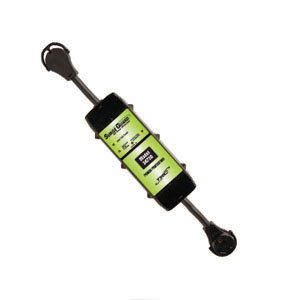Traveling from location to location, RV electrical systems are especially vulnerable to damage. That’s why owning an RV surge protector like the Technology Research Surge Guard makes sense. Naturally, RV surge protectors are available in 30 Amp (http://goo.gl/UkubwF) and 50 amp (http://goo.gl/hmBvXk) flavors. A surge protector is an investment in peace of mind for the RV owner.
The threat at hand pertains to voltage. Just what the heck is voltage, and why should we care about it?
You might think of voltage as being similar to water pressure. We’ve all experienced differences in water pressure. When water pressure is too high, pipe fittings may burst and leak. When it’s too low, you get a lousy shower (amongst other problems).
So you might think of voltage as being like electricity pressure. There is an ideal voltage. The standard voltage in the United States is 120 volts. If everything was perfect, voltage would remain at this constant figure.
However, in the real world, voltage tends to vary. Even during normal conditions, it might drop down to 110 volts, or spike up to 126 volts. But the code standard is 120 volts.

PROTECT YOUR RV with a surge protector. Here's the Big Boy 50 Amp unit. (CLICK THE PIC for more info.)
Most electrical appliances are designed to handle small variances in voltage, say from 105 volts on the low end up to 130 volts on the high end. 125 volts won’t kill your iPad. 115 volts won’t tank your A/C.
But problems happen when there are extreme variances in voltage. These problems can end up being expensive, mainly because electrical appliances and gadgets tend to be expensive.
Consider the stuff we haul around in our RVs that is frequently plugged into the electrical system. These days we’re carrying more high dollar electrical items than ever. A quick inventory of the average RV tallies up thousands of dollars in electrical gear.
In addition to the ubiquitous flat screen TV sets, we’ve got smart phones, laptop computers, and iPads.
Even digital cameras are now being plugged directly into wall outlets. In fact, pretty much everything with a rechargeable battery can be plugged into the electrical system.
Then there are integrated RV appliances like refrigerators and microwaves.
We also carry a Vitamix blender with us on the road. It would be a sad day indeed if that 2-horsepower blender motor was ever turned to toast.
All of these devices and appliances are vulnerable to variances in voltage. In fact, many appliances are vulnerable to under voltage as well as over voltage.
Consistent under voltage can damage devices like air-conditioning units. Compressors need plenty of voltage to start and run.
Yet spikes in over voltage can damage sensitive electronics like laptop computers.
The causes of voltage problems can vary.
Under voltage, sadly, is not uncommon in campgrounds. Often campground electrical systems are subpar in terms of consistent electrical voltage delivery. To paraphrase the detective in Casablanca, I’m shocked, shocked to find lousy wiring at an average campground. Yes, the pedestal outlets we all rely upon may be incorrectly wired.
It’s also true that some RV campgrounds experience tremendous variances in voltage due to the occasional use of large equipment like water pumps and so forth.
Other RV campgrounds even use generators for power. We’ve stayed at such campgrounds in the Yukon Territory. While the electricity is usually safe for electronics, do you want to bet all of your gear on it?
Of course, the most famous source of voltage spikes are lightning strikes. And yes, lightning strikes can kill expensive tech gear in an instant.
An RV surge protector offers electrical protection for an RV. The protectors sold by Surge Guard are particularly well regarded and offer some attractive features.
These surge protectors automatically shut off the power when they detect incorrectly wired pedestal, power surges, low and high voltage, reverse polarity, and dangerous current on ground wire.
After shutting off the power, they automatically reset on power restoration – after a 128-second reset delay to protect air-conditioning compressors.
These surge protectors even contain caution indicator lights that indicate the cause of power stoppage.
As mentioned above, these RV surge protectors are available in 30 Amp and 50 amp flavors.
Weather resistant cords are 10/3 AWG for 30 amp, and 6/4 AWG for 50 amp units.
When you consider the expense associated with electrical appliances, RV surge protectors are a reasonable investment in peace of mind.


